








All natural pork, beef and lamb raised sustainably and humanely by a community of more than 600 independent family farmers and ranchers to produce the highest quality meat.


100% Certified Humane ®
No antibiotics or added hormones—EVER
No crates—EVER
Raised outdoors and in deeply bedded pens
100% vegetarian feeds





Photo By Iliasis Muniz
This season and this issue are special to me. In these pages, we cover one of my favorite childhood traditions, one specific to Hispanic culture: cascarones. I loved Easter because of the food, the weather (my family got together outside) and the fun tied to it. Traditionally in my home, a leg of lamb was served with all of the other staples: potato salad, fajitas and guacamole. I remember painting eggs with my sisters and my dad at the grill. The adults watched us kids, with our baskets, hunt for cascarones. Miriam Perry explains how the cascarones tradition evolved over time, how it made its way to the Rio Grande Valley and how local organizations have used it as a way to raise money for their community.
Speaking of Easter, the recipes provided in this issue are holiday favorites. Alfredo Garcia gives us his take on pollo asado, a recipe in his upcoming cookbook (order a copy for new twists on some traditional recipes). Carla Saenz Martinez shares her grandmother’s recipe for potato salad, which, surprisingly, is similar to my grandmother’s. Adam Cavazos gives deviled eggs a new, delicious way. In Last Sip, Luis Zuniga creates a fun, fizzy and fruity drink that you can serve a big group or one for yourself.
I’m thrilled to report that Edible Rio Grande Valley held its first Ranch to Table dinner, and you will get to read all about it in this issue. The location was picturesque, the food was mouthwatering and the evening was magical. Arturo Ramon II created the menu. Daniela Loera and Michael Gonzalez captured the event in images. The next one in the series will be held at the Brownsville Shrimp Basin, making it our first Gulf to Table dinner. Stay tuned for details.
In our Community piece, we feature a couple dedicated to teaching and fostering organic farmers in the region through its HOPE for Small Farm Sustainability nonprofit organization. We share their recent news, recipients of a grant that will help them keep working toward accessible organic food for all. If you get the chance, stop by HOPE, see what the group is doing and buy some of its local produce.
I am always humbled and touched when share my thoughts with you. It is a honor to bring you these stories and meet the people throughout the 956 who are cultivating our food and food culture. I am extremely proud to be from the Valley. Bringing ERGV to you would not be possible without our advertisers, so we thank them for their continued support. We are always on the hunt for more businesses that appreciate what the Valley has to offer.
I hope you enjoy our Spring issue,

Jacqueline Folacci Publisher


Edible Rio Grande Valley is published quarterly. Subscribe and have it delivered right to your door. You can subscribe online at edibleriograndevalley.com or mail a check for $28 to: 415 Calle Retama, Brownsville, Texas 78520.

PUBLISHER
Jacqueline Folacci
EDITOR
Letty Fernandez
CONTRIBUTORS
Adam Cavazos
Steve Clark
Alfredo Garcia
Carla Saenz Martinez
Miriam Perry
Arturo Ramón II
Luis Zuniga
PHOTOGRAPHERS
Micheal Gonzalez
Daniela Loera
Ismael Martinez
Iliasis Muniz
Yvette Vela
ILLUSTRATORS
Jazmin Aguilar
LAYOUT DESIGN
Matthew and Tina Freeman
COPY EDITORS
Doresa Banning
Marci Caltabiano-Ponce
Sammy Jo Cienfuegos
Cristina Tijerina
ADVERTISING
advertise@edibleriograndevalley.com
CONTACT US hola@ediblergv.com
TO SUBSCRIBE
Visit us online at edibleriograndevalley.com edible Rio Grande Valley is published quarterly by GC Publishing LLC. Subscription rate is $28 annually.
No part of this publication may be used without written permission of the publisher. Every effort is made to avoid errors, misspellings and omissions. If, however, an error comes to your attention, please accept our sincere apologies and notify us at hola@ediblergv.com. Thank you.
©2025. All rights reserved edibleriograndevalley.com









First Dinner Features Open Fire Cooking at Historic Ranch

With our To-Table Series, we aim to bring together our readers at a remarkable place, to enjoy an excellent meal, meet new people and celebrate the food culture of the Valley.
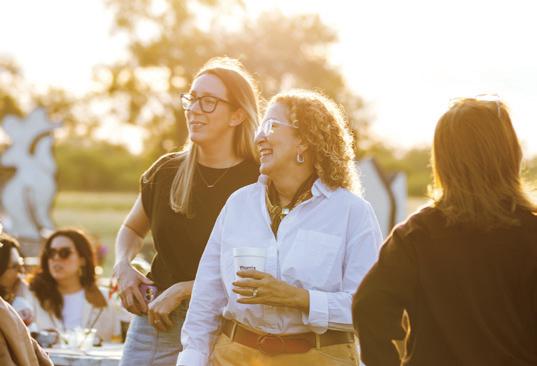
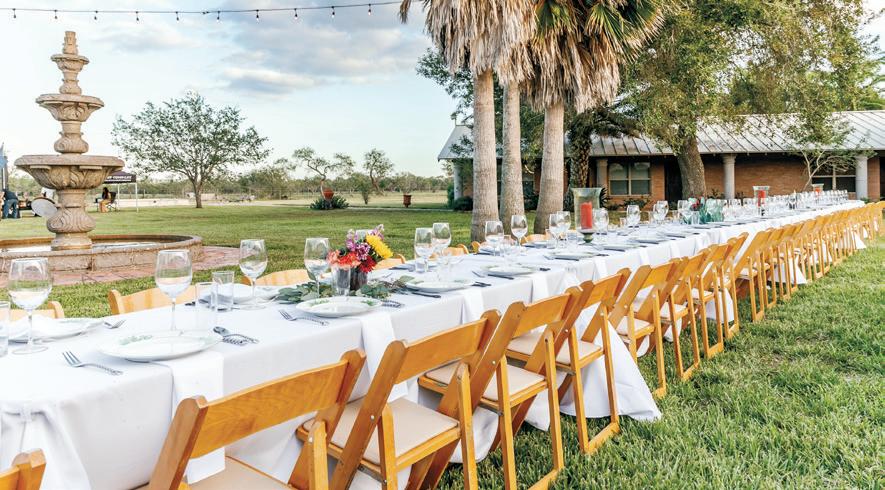
On a cool November evening, a full moon lit the sky as 75 guests from our region and beyond joined Edible Rio Grande Valley at our first Ranch to Table dinner.
The setting was the scenic Hacienda Yturria Ranch north of Raymondville, founded in 1858 by Francisco Yturria, a pioneer, merchant, banker, railroad developer and rancher. His thirdgreat grandson Jason Wolfe helped us plan this community gathering.
Historically, cattle and horses were raised at the ranch. Today, part of the property serves as a habitat for native and exotic wildlife, such as javelinas, waterbucks, lechwe, bobwhite quail and caracaras.
This evening of food and fellowship began with cocktails sipped against a backdrop of the setting sun. Next, our guest took their seats at one super-long table ready to enjoy the six delicious courses that followed.
Arturo Ramon, Brownsville native and owner of Blanco River Meat Co., who created the menu to include mouth-watering selections that featured fresh, local ingredients prepared over an open fire.




To bring his culinary vision to life, Ramon assembled a rockstar team that included Eddy L. Morales, The Pitfather BBQ and grand prize winner of the San Antonio Bar-B-Que Cook-Off, and Victor Cavazos, owner of El Camino Social Club restaurant and bar in Brownsville and maker of delicious paella.
The final course, dessert, was ice cream from Eddie Moreno of Layers Ice Cream in Weslaco, two fall flavors developed specifically for the event.
Wine, from family-owned Amici Cellars in Calistoga, Calif., accompanied the dishes. Michael Pennington of L&F Distributors in McAllen helped us choose the types and shared his wine knowledge with our guests.
True to ERGV’s mission, most of the foods for the dinner were sourced right here in the Valley — wild gulf shrimp from Snodgrass Inc. in Brownsville; cabritos from J. Galvan Mini Farm in Donna; quail from Kiki’s Farm in Hargill; beef cheeks from England Cattle Co. in Mercedes; lion’s mane mushrooms from One Up Mushroom Products in Mission; and microgreens from Little Leaf Microgreens in South Padre Island.
We owe a huge thank you to the local farmers, ranchers, food and drink artisans who helped us bring this special experience to the Valley. We invite and encourage you to support these businesses. I hope you will join us for the next To-Table Dinner; be sure to sign up for our newsletter and be the first to hear the details.
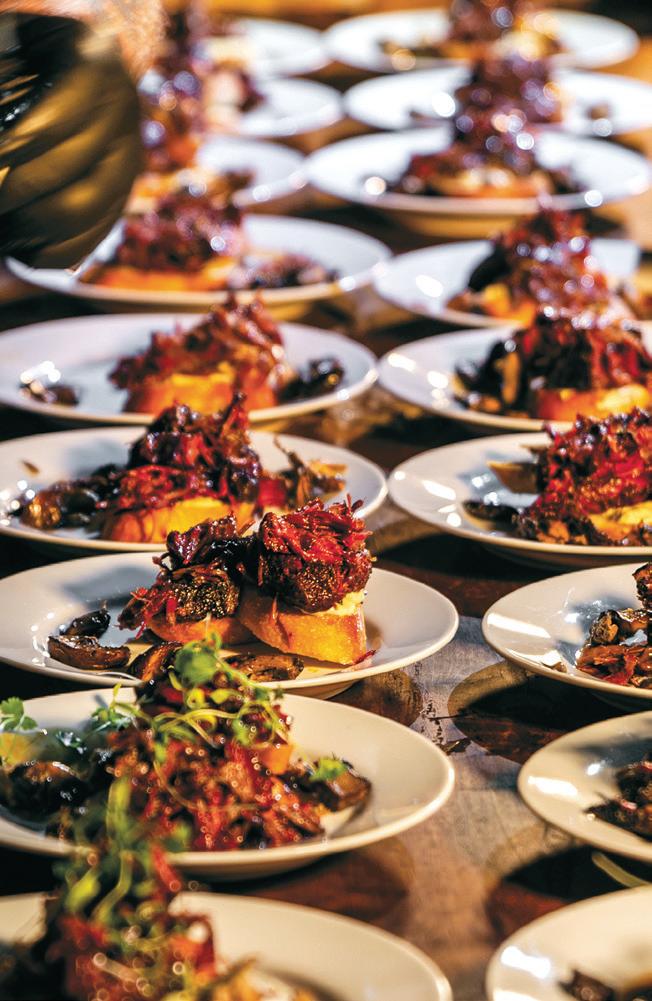

by


By Arturo Ramón II, Texas grillmaster
There a few things you can do to ensure perfect openfire cabrito.
• Select a true milk-fed animal from a rancher who cares. The ones from Nuevo León, Mexico, are the best, in my opinion.
• Your selection of fire/wood matters. Traditionally, mesquite wood is used in Mexico and South Texas. I find that if the mesquite wood isn’t cured long enough, the smoke makes delicate meat have an astringent flavor. I like using a white oak or post oak to start. It is a very mild wood. Then to finish, I like using oak charcoal.
• It’s all about rotation. Constantly rotating will allow the meat to render its fat, building a crust but not burning the flesh.
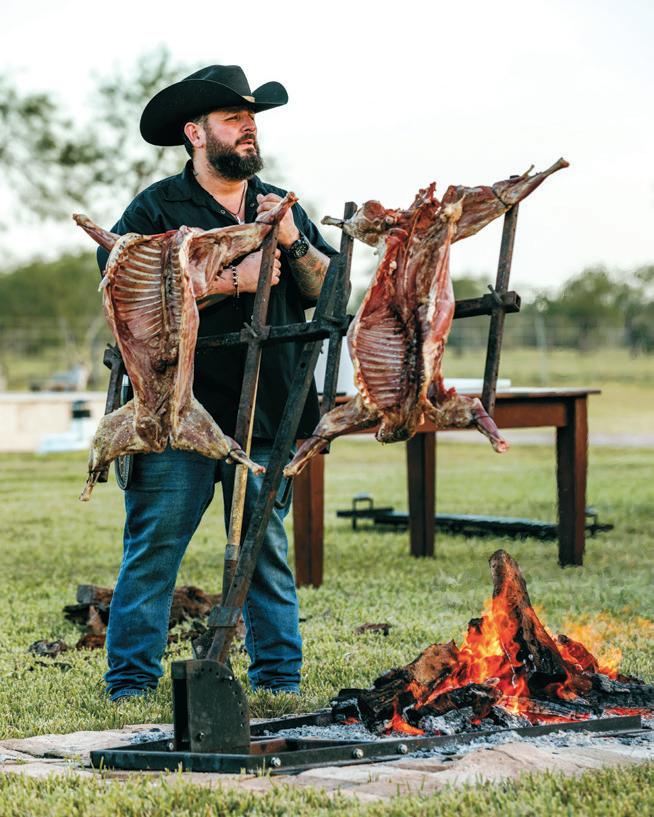
• Do Not Overseason! This is where most folks mess up. They try and do all these marinades and tons of spices and salt. This is not necessary. Cabrito is a sweet delicious meat that only requires just a little salt and finely ground pepper.
• To baste or not to baste? I find that basting the animal with melted duck fat is the absolute perfect way to brown meat without taking anything away from the flavor.
• When is it ready? The animal will let you know.
• As the cabrito cooks, it will soften and get very tender. A surefire test of whether it is ready is to gently pull one of the legs. If the cabrito is ready, the leg will detach easily.
• Make some salsa, warm up some tortillas and enjoy one of the world’s best foods!
Raised in South Texas, Arturo Ramón II spent his youth learning to cook whole animals over an open fire with his father and grandfather. He began working in the restaurant industry at the age of 16. Ramón has a successful catering company, Blanco River Meat Co., based in the Texas Hill Country. Construction of his restaurant, also there, is underway with plans to open the doors
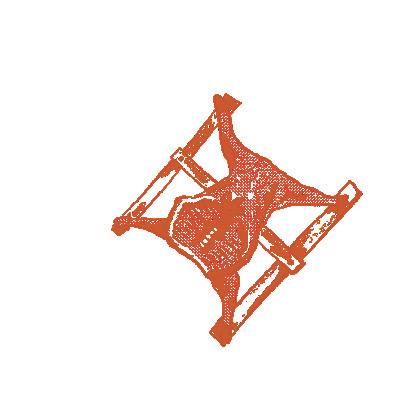
STORY

IPERRY |
f you were to stroll the cobbled paseos of French-ruled Mexico City in 1865, you might encounter a strange sight: a flirtatious young gentleman tossing dyed eggshells filled with perfumed powder, slivers of gold paper and trinkets at a fetching señorita, hoping that his overture will garner her favor — or, at least, her attention.
No one is certain where the idea of upcycling chicken eggs into a flirtation device originated. That truth vanished in the hazy merengue of centuries. Some accounts trace the peculiar practice to 13th century China and Marco Polo, who allegedly introduced it to Italy, followed by migration to France and Spain.


“Who we are is who we were. Regardless of where the tradition came from, it is a link to past generations and centuries. Cascarones do this.”
— Dr. Manuel Medrano, professor emeritus of Mexican-American Heritage and Culture at the University of Texas Rio Grande Valley
Cue the New World
What we know is that Empress Carlotta, wife of France’s emperor of Mexico, Maximilian, arrived in 1864, European customs in tow. Some disappeared with his ill-fated reign, although this particular curiosity swept north across the Rio Grande. Now, there’s no denying the popularity of the Valley tradition of cascarones
In Deep South Texas, cascarones evolved to delight youngsters quite differently. At Easter egg hunts in countless yards, children scramble to fill baskets with confetti eggs while assessing the competition. Sneaking up from behind, they crunch them on unsuspecting victims’ heads, scattering bits of colored paper to the Gulf winds. Some make wishes and hope they come true. Good luck? Perhaps. Messy? Definitely — but oh, so fun.
Dr. Manuel Medrano, professor emeritus of Mexican-American Heritage and Culture at the University of Texas Rio Grande Valley,
considers the longevity of cultural touchstones over centuries. “Traditions are pliable,” he says, “a confluence of the past and present. What you use in a tradition correlates to how much passion you have for the tradition.” Thousands of eggs expended annually in cascarón -making prove his point.
Today, Becky Taylor McClendon treasures the miniature artworks her mother, Elizabeth White Taylor, painted 60 years ago. She recalls preparing cascarones at home and at Church of the Advent, Episcopal, in Brownsville, before Easter.
“I can still see our kitchen filled with eggshells. We ate dozens of scrambled eggs so Mother would have enough,” says McClendon. “Her eggs came from Tucker’s Egg Farm, across the cotton fields, not far away. Mother would puncture each end and use the contents for baking cakes and pies from scratch. We would wash and dye them pastel colors and set them on racks to dry.”
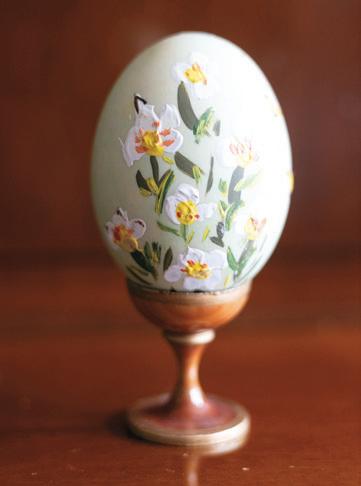
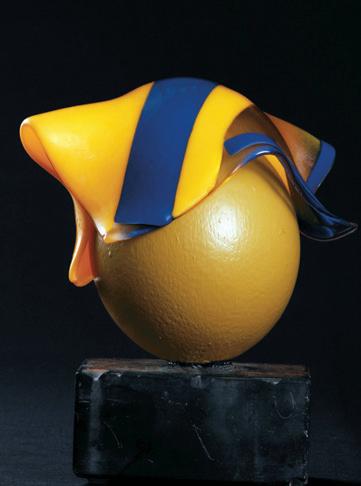
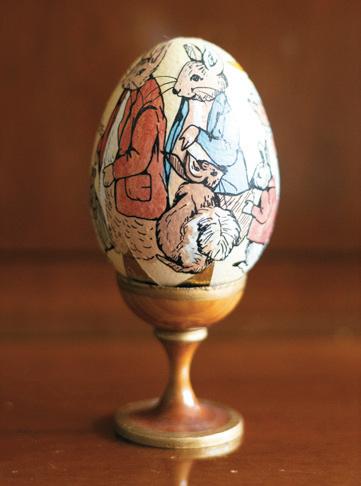

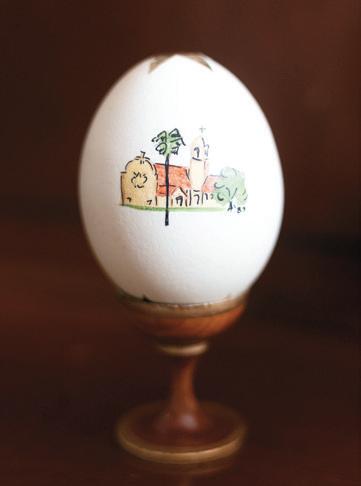
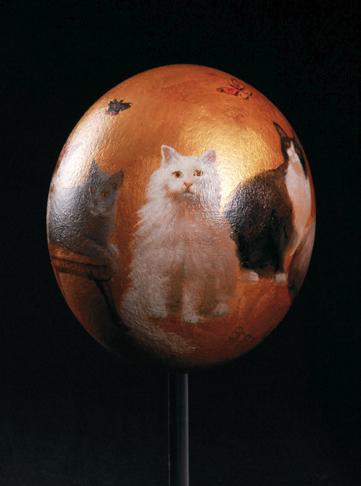



Enter the magic Cascarón makers gather before Holy Week in kitchens, classrooms and fellowship halls, Valleywide. Using spangles, glue and fine brushes, they add love and patience to yield a sum greater than its parts. After sealing the confetti eggs with glue and tissue paper, their alchemy emerges in designs — realistic and fantastic — painted onto the fragile orbs. A frothy seascape, a balding friar, Pogo Possum. Artists sometimes sign their work, hoping it survives. The Church of the Advent’s “egg ladies” still display standouts, as they have for 75 years.
Some eggs never make it to the display case. Too beautiful for child’s play, Viveca Crixell Serafy’s cascarones comprise her private collection. It began in 1983 with an egg her late mother-in-law, Jean Serafy, bestowed in honor of newborn son, Nicholas. “As our family grew, our collection grew,” she says. Nestled in Waterford crystal bowls at Easter, the children knew to look, not touch, and certainly never to break.
One twist on decorating eggs, loosely based on cascarones, uses a grander canvas — ostrich eggs. In 1985, Easterseals RGV in McAllen hatched a plan to paint and sell a clutch of these mammoth eggs as a fundraiser. The idea took flight.
What you will need:
• Water, eggs, white vinegar, liquid dyes or food coloring
• Needle, cake rack, baby spoon, paper funnel
• White glue, tissue paper or large foil stars, decorations
With a needle, carefully poke a small hole in the pointed end of an egg. Poke a larger hole in the opposite, rounded end.
Blow through the smaller hole until you force the egg white and yolk out of the larger end.
Repeat the process with as many eggs as you wish to decorate.
Rinse hollowed-out shells. Set on cake rack to dry 1 to 2 days, turning occasionally.
“Word got around until, now, it’s tradition,” says Executive Director Pattie Rosenlund. Proceeds support early childhood and disability programming. “Artists like Luis Sottil, Sister Norma Pimentel, Berry Fritz and Dania Olivares are highly sought after by collectors.” With Lilliputian precision, they depict a lazuli bunting in eyepopping plumage, Our Lady of Guadalupe, New York’s Chrysler Building, The Last Supper. Over a dozen eggs hit the auction floor each fall, gaveling up to $10,000. The coveted Carats’ “Mystery Egg” requires the winner to crack it, liberating jewelry within.


Some might ask why, in a world besotted with fast fashion and flash fiction, anyone would devote time and effort to making something as antiquated as cascarones Medrano believes their constancy speaks to their significance.
“Who we are is who we were. Regardless of where the tradition came from, it is a link to past generations and centuries. Cascarones do this.”
Miriam Perry, a Brownsville native, is commissioner of beautification and environment for the city of Nashville. She promotes culture and green spaces in the South.

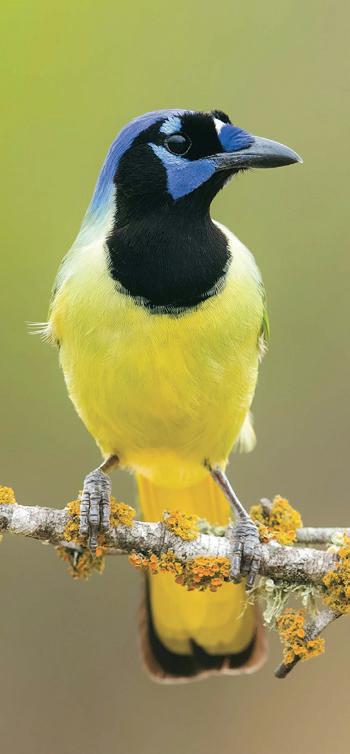
Boil ½ cup of water for each color to be used. Add 1 teaspoon white vinegar per ½ cup.
Into individual small bowls, pour ½ cup of the liquid and add 8 to 10 drops of dye to each.
Use a slotted spoon to dip each egg into the dye. Let sit at least 5 minutes.
Remove eggs and allow to dry on rack.
Using a baby spoon and paper funnel, fill eggshell with confetti through larger hole.
Cut and glue a small, round piece of tissue paper (or large foil star) to the larger hole to seal it.
Decorate the dry eggs with paint, stickers, Washi tape, glitter or pictures cut out from magazines.
Have fun!


Nonprofit lands USDA grant to teach farming, sustainability
“We just have to be creative and kind of work together to do it. … I think that’s the way we can improve our food system, by creating a whole bunch of small farmers like they did a long time ago. You put it all together and you provide food for your local community. If something happens, we all have food.”
—Diana Padilla, founder of HOPE for Small Farm Sustainability
Diana Padilla thinks everyone should have access to healthy, organic food, so she started raising farmers.
A $7.4 million grant from the U.S. Department of Agriculture was awarded in May of 2024 to HOPE for Small Farm Sustainability, the nonprofit organization Padilla established for that purpose, should help quite a bit.
It all goes back to 2005, when she and her husband Saul bought 15 acres south of Harlingen. In 2008, it was christened Yahweh’s All Natural Farm and Garden. Today the farm covers 75 acres and grows beets, broccoli, cauliflower, lettuce, moringa — a supplement — and squash. The Padillas also raise chickens, cattle, lambs and pigs.
After selling at the Brownsville Farmers’ Market for a few years, the couple discovered Community Support Agriculture (CSA), essentially a farm-to-table subscription service, and that’s how the Padillas sell their produce and proteins these days.
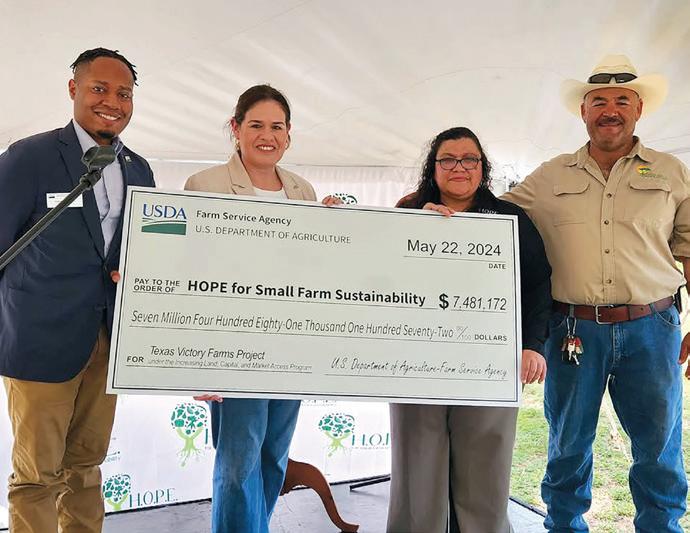
“It is the best way for people like us to sell our product, because people buy memberships that are prepaid,” Diana says. “And we have working capital. We don’t have to go to the bank. We have money to work with.”
Saul has farming in his genes, while Diana describes herself as “the entrepreneur,” with a background in real estate, restaurants and whatnot. As Yahweh’s production ramped up, “people started getting more and more interested,” she says.
At some point the Padillas began sharing what they knew with others, and the rest is history. HOPE, founded in 2012, stands for “Holistic Organic Practical Education.”
“It’s grown exponentially,” Diana says, referring to her nonprofit.
Calling its project “Texas Victory Farms,” HOPE applied for
the USDA grant through the agency’s Increasing Land, Capital, and Market Access Program. The overarching goal of the project was described as “increasing land, capital, and market access opportunities for the target audience of socially disadvantaged beginning farmers, ranchers, and refugees by providing relevant training, land and shared infrastructure, and equipment.”
HOPE, which occupies six acres at Yahweh Farms, proposed replicating the peer-to-peer training it was already offering there and expanding it to sites in Donna, Mission and Santa Rosa as well as Dallas and Waco. The land was to be donated by religious institutions and “collaborating farmer trainers,” according to the project description.

HOPE also proposed buying property — which is super expensive these days — “to help preserve land for future expansion and ensure the economic sustainability of this project.”

USDA gave the project the green light, and now HOPE has $7.4 million at its disposal over five years to make it a reality.
“This one is what I call a dream grant,” Diana says.
The lion’s share will go to buying land for community farming, where fledgling farmers will learn to farm, though some portion will be spent on equipment — tractors for instance, one each for the upper and lower Coastal Bend, Diana says. The grant will also pay for staffing of the program over the five-year grant period.
Texas Victory Gardens aims to buy land in Central Texas with the $4.4 million set aside for the purpose.
“I just think that local people have the answers to some of the problems,” she says. “We just have to be creative and kind of work together to do it. … I think that’s the way we can improve our food system, by creating a whole bunch of small farmers like they did a long time ago. You put it all together and you provide food for your local community. If something happens, we all have food.”
Currently eight gardeners are working on their gardens in Harlingen. About 180 people have expressed interest in participating
and have attended workshops. They are divided into four categories: land owners with farming experiencing, land owners without farming experience, those without land but with farming experience, and those without land or farming experience. Within the overall group are 14 or 15 individuals who already have farming operations but want to expand.
“We’re calling those the elite,” Diana says. “Those are the ones that we’re going to show how to do a CSA and expand what they’re already doing.”
Experience gained through the program will enable eligible participants to obtain low-interest Farm Service Agency loans to buy their own land, if they choose.
As for the next step, once Texas Victory Gardens has conquered Central Texas, Diana says she wants the program to keep growing, just maybe without her. She has her own farm to worry about, after all.
“I’m looking for a whole bunch of people like me to make this organization bigger, maybe go national,” she adds. “Because if it works, why not? Then, for me, I’ll retire for the third time.”
Steve Clark is a writer living in Brownsville. In his spare time he enjoys playing banjo and guitar, canoeing with his lovely wife Laura and eating and writing about great food.
Anyone interested in learning more about Texas Victory Gardens, or offering services as a volunteer, can message HOPE for Small Farm Sustainability through its social media pages, by emailing foodconnectors@ hopeforsfs.org or by calling 956-412-4916.
March – May
Beets* *
Bell Peppers ***
Broccoli **
Cabbage**
Cantaloupes ***
Cucumbers **
Field Peas ** Green Onions **
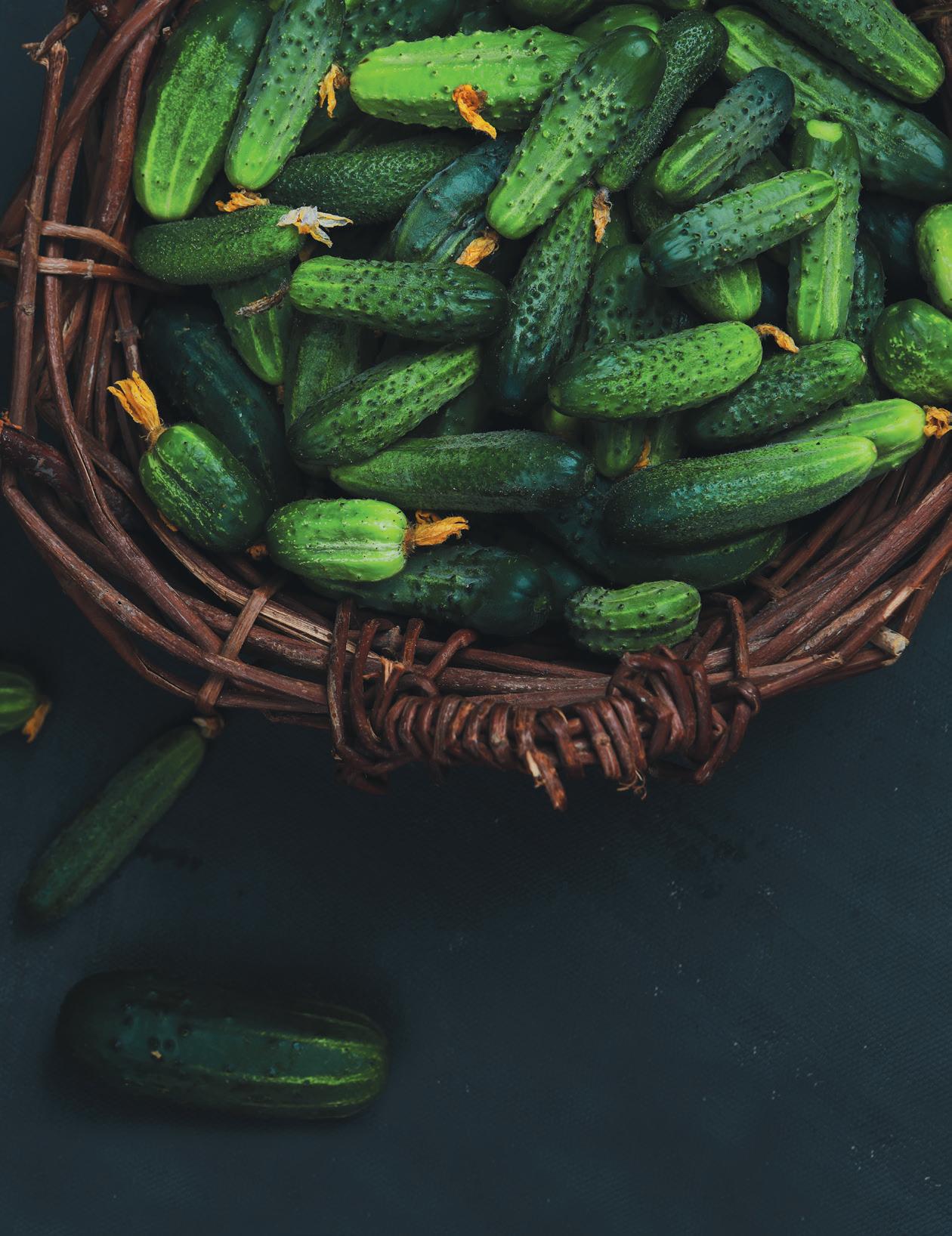
Greens ** Honeydews *** Melons *** Onions **
Spinach * Strawberries ***
Sweet Peppers *** Watermelons ***
What to Plant
Corn * Cucumbers*
Eggplant * Hot Peppers * Snap & Lima Beans * Sweet Peppers ** Tomatoes*
March Only * March & April ** May Only ***
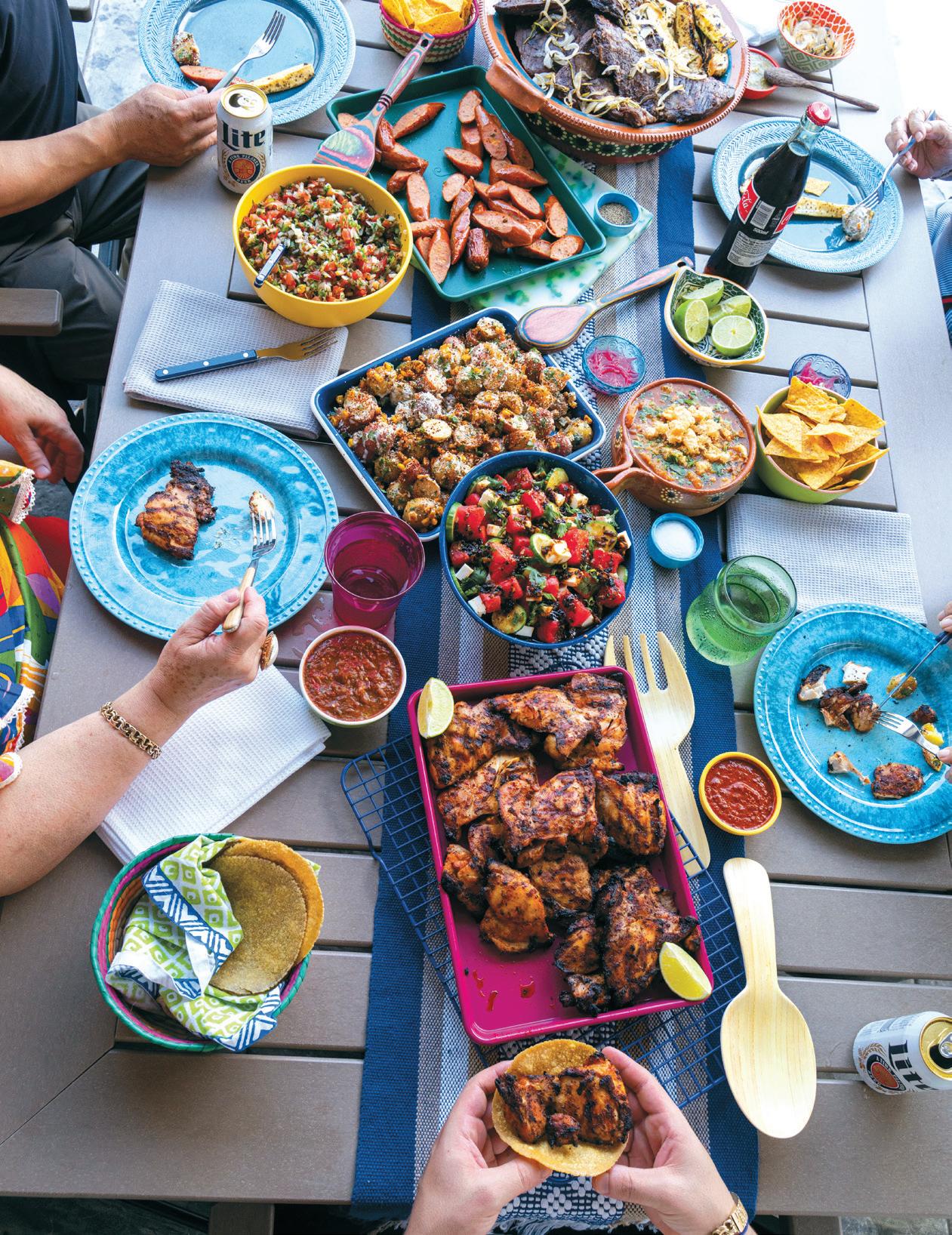
Alfredo Garcia always wanted to create a cookbook, and he’s done it with Let’s Make It: A MexicanAmerican Culinary Adventure, slated for official release on April 22.
“It still feels surreal. I cry a little bit every time I think about it,” says Garcia, “that I actually wrote a book that is being published, and anyone will be able to buy it, read it and cook from it.”
Born in the Rio Grande Valley but raised in Chicago, Garcia gained a love of cooking as a youngster. Better known as Freddsters on Instagram, he’s been creating content full-time since 2021. Before, he was a private chef for multiple Major League Baseball players. His debut commercial product, Salsa Macha, is always sold out.
In this ERGV issue, we feature a recipe for Pollo Asado, which Garcia has been making for years.
LETTY: How did you get into cooking?
ALFREDO: Everyone in my family loves to cook, so growing up I was always around food. After school, I watched cooking shows on the Food Network religiously.
Most of my love of cooking came from my mom. Every day after school she would be in the kitchen making us dinner. On weekends, my family all would be in the kitchen watching TV while breakfast was being made.
I grew up with Mexican food 24/7; it’s all my mom would make for us. I learned about other foods from the Food Network, traveling and social media.

LETTY: How did the cookbook come about?
ALFREDO: A dream of mine was always to write a big hardcover cookbook that you could walk into a store and buy. Some opportunities came up to write a cookbook, but they weren’t what I wanted.
Out of the blue in 2023 I got an email from my now editor, Molly Ahuja. She asked if I was interested in writing a cookbook. I immediately replied, we had a couple meetings and the contract was officially signed towards the end of 2023.
LETTY: Tell us about the process.
ALFREDO: I spent two to three months coming up with the recipes. It was hard to limit them to 100. Then I got in the kitchen. Being a home cook, I don’t always use exact measurements, but for the book, even with recipes I have made many, many times, I had to re-make them, writing down every single measured ingredient and the entire process, step by step.
Every day I would cook three to five recipes and take notes on everything. For almost a month, I would send a big group text to family and friends, saying I had food available, first come, first served.
LETTY: How did you choose the recipes for the book?
ALFREDO: A handful of them were no brainers, like salsa verde, arroz rojo, frijoles, barbacoa, chilaquiles and tacos al pastor. Beyond these traditional recipes, I knew I had to distinguish my book from the traditional fully Mexican cooking cookbook.
I started experimenting, mixing traditional Mexican dishes with cuisines from all over the world. I came up with recipes like Mexican Chicken Parmesan, where instead of the traditional tomato-based sauce, I make it with either a creamy chipotle sauce or the vibrant green sauce from Espagueti Verde. I made a pico de gallo but added kimchi to it, a delicious spicy fermented cabbage. I made cheeseburger flautas. I added matcha to a traditional tres leches cake. They are all recipes that you may be familiar with, but with a little Mexican influence throughout.
LETTY: Do you have a favorite recipe in your cookbook?
ALFREDO: I think my favorites would have to be the Elote/Esquite recipes with different preparations.
LETTY: How does it feel to be a published author?
ALFREDO: I have been collecting cookbooks for about 10 years, and I have over 300. Now one of them will be MY cookbook. It truly is one of the greatest things I have ever been able to do, and I am so grateful that I was given the opportunity. I am so ready to write a second one. I already have a list of recipes I am working on.
Follow Garcia on Instagram @freddsters, and in his bio there, find links to where to preorder Let’s Make It!
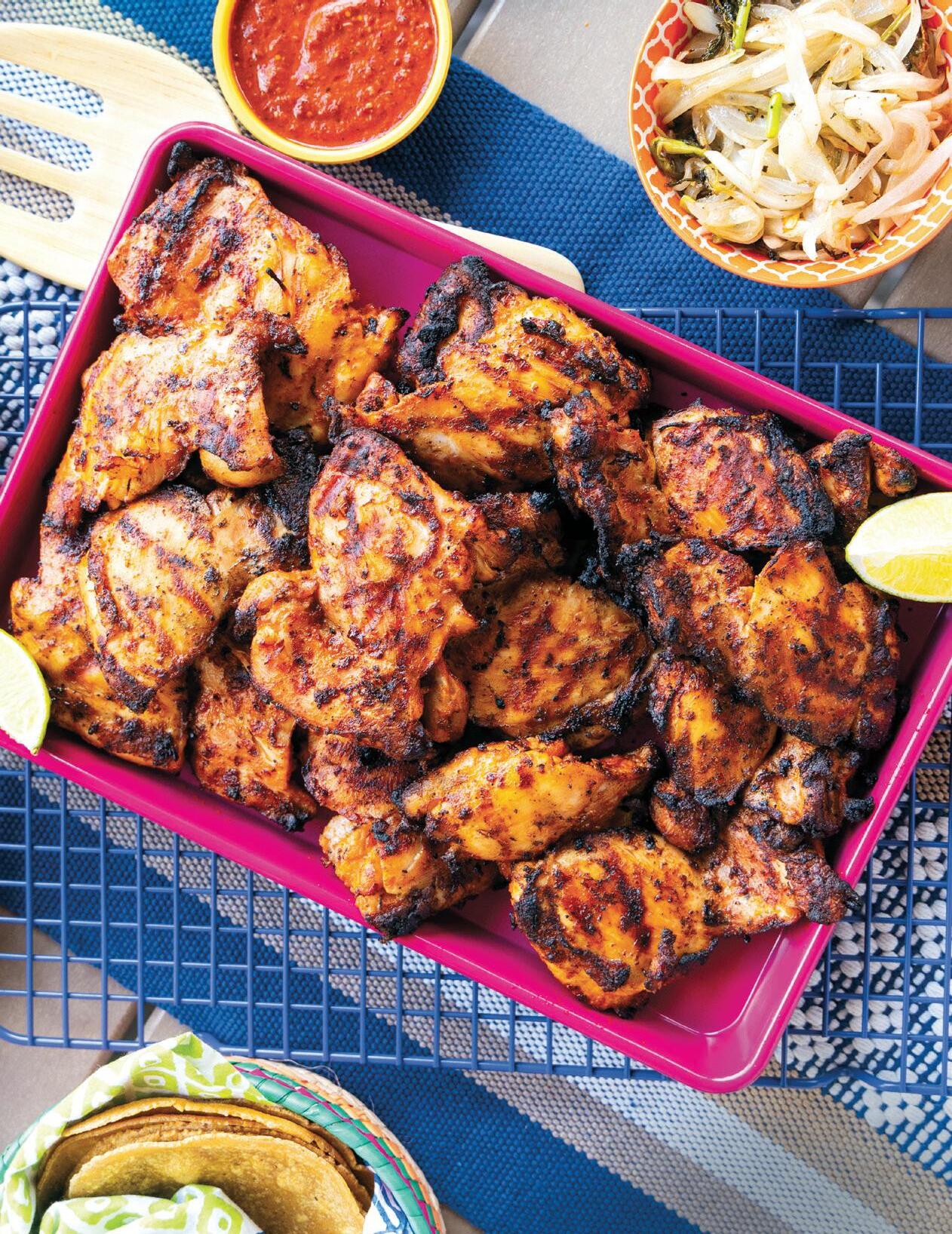
Recipe by Alfredo Garcia Serves 4–6
“For as long as I can remember, my mom has been using mayonnaise as the main ingredient for marinating chicken that we’re going to grill. The mayonnaise ensures that your chicken will remain moist no matter what, even the white meat which is notorious for being dry. I prefer to make this recipe with chicken thighs, but you certainly can use chicken breasts or a combination of the two.”
1 cup (236.6 ml) mayonnaise
2 tablespoons (13.6 g) paprika
1 tablespoon (15 g) Tajin or chile-lime seasoning
I teaspoon (5 g) cumin
1 teaspoon (2.4 g) onion powder
1 teaspoon (3.1 g) garlic powder
1 teaspoon (3.2 g) guajillo chile powder
2 teaspoons (10 g) kosher salt
1 teaspoon (2.3 g) black pepper
¼ cup (71.75 g) diced chipotle peppers in adobo
3–4 pounds (1–2 kg) boneless, skinless chicken thighs or breasts
In a big mixing bowl, place all the ingredients, except the chicken. Mix them well to combine. Add the chicken thighs and mix to combine, making sure they are fully coated.
Cover the bowl with a lid or plastic wrap and place it in the fridge to marinate for at least 2 hours or up to overnight. When ready to cook, remove the chicken from the fridge.
Get your grill nice and hot. Once hot, start cooking the chicken in batches as needed. Cook the chicken thighs for 3 to 5 minutes on the first side. Flip over and cook for another 4 to 5 minutes. Continue with all the chicken until complete.
Let the chicken cool for 5 minutes before slicing and serving.
If using chicken breasts, cut them in half lengthwise to make cutlets, so they aren’t too thick and can cook faster.
You can make this recipe indoors using a large frying pan set over medium-high heat. Cook the chicken for about 4 to 5 minutes per side.



Hours: Thursday - Saturday from 4 to 10pm Sunday, Tuesday & Wednesday from 4 to 9pm
956-351-5528
601 S. Texas Blvd. Weslaco, Texas

• Get early access to events • See what seasonal veggies to plant and eat • List of upcoming food events in the RGV
Scan the QR code above or visit edibleriograndevalley.com to sigh up today.
Recipe by Adam Cavazos, chef and owner, Bodega Tavern & Kitchen in McAllen
Makes 30 servings
“Giving people things they’ve seen before but in a new way is what we do at Bodega a lot. This applies to the deviled eggs. While we love the classic mustard and mayo filling, we wanted to have something unique in our menu that could be eaten any time of day.
Our idea was to take the flavors that might be on your plate when having pancakes (syrup, bacon, eggs, hot sauce) and put them into one bite. So our filling consists of maple syrup, puréed dried chiles and mayo of course, and we finish it with crispy chopped bacon.
They’ve been a staple since day one, and they were the first item to ever leave the Bodega kitchen!”
15 large eggs
½ cup (118.3 ml) mayonnaise
½ cup (118.3 ml) Dijon mustard
½ teaspoon (2.5 ml) Tabasco
½ teaspoon (2.5 ml) Worcestershire sauce
Salt and white pepper, to taste Chives, finely chopped, for garnish
Bring a pot of water to a rolling boil. Carefully drop eggs in using a slotted spoon or strainer. Once all the eggs are in, return to a boil and set a timer for 12 minutes.
Once cooked, remove from the water. Place into a bowl filled with ice water and allow to cool completely.
Remove from the water (don’t discard water) and peel eggs. Cut each egg in half lengthwise. Remove the yolk and place into one container. Using the reserved water, rinse the egg white, so it is clean and free of any leftover yolk or shell. Place it into another container.

Next place yolks, mayo, mustard, Tabasco and Worcestershire into the bowl of a food processor. Blend until smooth, taking care to scrape down the sides as necessary. Season with salt and white pepper to your liking. Place mixture into a piping bag fitted with your favorite tip and chill in refrigerator for 30 minutes.
Make sure your egg halves are dry and arrange them on a serving platter. Fill the hole of each with a small amount of the mixture and sprinkle with chives.
Variations
Spicy honey and bacon: Substitute the mustard with ¼ cup (59.1 ml) honey and ¼ cup (59.1 ml) sriracha. Top with crispy chopped bacon.
Avocado: Substitute the mustard with ½ small avocado. Add in juice of ½ lime. Top with pico de gallo.




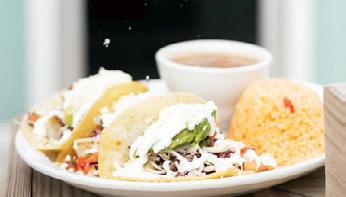

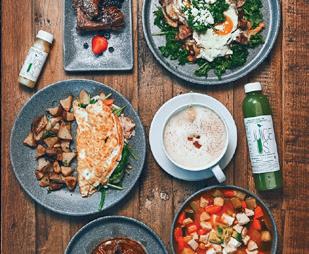


Recipe by Carla Saenz Martinez, Brownsville Makes 8 servings
“Easter was our favorite holiday. It was a tradition to go to my grandmother’s ranch north of Alice, Texas, after Mass. Every year, the men would clear brush around a shade of trees for us to set up tables and build a campfire. Our extended family and friends would celebrate a traditional family event that always featured my grandmother’s potato salad.”
4–6 large russet or Yukon gold potatoes, unpeeled and boiled
½ cup (118.3 ml) Hellmann’s, Duke’s or your favorite brand of mayonnaise (add more depending on number of servings)
1–2 tablespoons (15–30 ml) pickle relish
1–2 tablespoons (14.8–29.6 ml) regular mustard
4 stalks celery, chopped (add more depending on number of servings)
½ cup green olives with pimentos, chopped
Olive juice
¼ cup red or other onion (optional)
2 tablespoons (18.6 g) green pepper, chopped (optional)
4–6 hard-boiled eggs
Salt and pepper to taste
Paprika
Boil unpeeled potatoes until soft, and set aside to cool completely. Once completely cooled, remove the skin, cube the potatoes and set in a large bowl.
Boil eggs until hard, and set aside until completely cooled. Once cooled, remove the egg whites and set the yolks in a small

bowl. Chop the egg whites and add to potato mixture.
Chop celery, onions, green pepper, green olives and pimentos and add to the potato mixture. Add pickle relish to potato mixture.
Add small amount of olive juice to potato mixture for flavor.
Add mustard to the egg yolks in small bowl and with a fork, mash into a mustard paste. Add the mustard paste to the potato mixture. With a large spoon or spatula, mix the mayonnaise and gently fold into the potato mixture. Add salt and pepper to taste. Sprinkle potato salad with paprika.
Enjoy!

Brownsville
Brownsville Farmers Market

Linear Park, 1534 E. 6th St. Saturdays 9AM-12PM brownsvillewellnesscoalition.com @brownsvillewellnesscoalition
Donna Heart of the Valley Farmers Market
120 S. Main St. 3rd Sunday of every month 2-5PM @heartofvalleyfm
Edinburg
Hub of Prosperity Urban Farm
3707 W. University Dr. Saturdays 9-11AM openfoodnetwork.net @hub_of_prosperity
Harlingen
Harlingen Farmers Market
Tyler Avenue & 2nd St. Saturdays 3-4:30PM Mid October-mid June harlingenfarmersmarket.com @harlingenfarmersmarket
Laguna Vista
SPIGC Community
Farmers Market
South Padre Island Golf Course
1 Ocelot Trail Rd.
1st & 3rd Tuesday of the month 4–6PM
McAllen
Farm to Table Tres Lagos
Farmers Market
4350 Tres Lagos Blvd.
1st Sunday of every month 2-5PM visitmcallen.com @treslagosmcallen
Grow’n Growers
Farmers Market
Firemen’s Park, 201 N. 1st St. Saturdays 9AM-12PM visitmcallen.com @farmersmarketatfiremenspark
McAllen Farmers Market
4001 N. 23rd St. Saturdays 10AM-1PM mcallenfarmersmarket.com @mcallenfarmersmarket

Primera
Primera Market
City Hall, 22893 Stuart Place Rd.
3rd Thursday of the month
4:30–7:30PM (956) 423-9654 or ecavazos@primeratx.gov
Rancho Viejo
Rancho Viejo Farmers Market 3301 Carmen Ave.
Every other Sunday 3-6PM ranchoviejofm.com @ranchoviejofarmersmarket
San Benito
El Pueblito Market
101 N. Reagan St. 2nd Saturday of the month 11AM-3PM elpueblitomarket956@ gmail.com
Market Days on Historic Robertson Street
Available CSAs in the RGV CSA, or Community Supported Agriculture (CSA), is one way consumers can directly support local farms. You connect directly with the farmer, and every week your farmer delivers or you can pick up a variety of fresh nutritious food.
All CSAs have different financial structures and procedures, so we suggest you reach out to the CSA for more information.
CD&J Mini Ranch Offers a produce CSA Meat and egg CSA
29575 Adams Rd., San Benito cdjminiranch.com @cdjminiranch_woman_owned
Nature’s Heartland Farm Offers produce and eggs 11920 N. Mile 16, Edinburg Saturdays 10AM-4PM heartlandfarm.com @naturesheartland

HOPE Farmers Market 19833 Morris Rd. Mondays & Thursdays-Saturdays 10AM-6PM yahwehfarm.com yahwehs.farmgarden@gmail.com @yahwehsfarm hopeforsfs@yahoo.com hopeforsfs.org
Wild August Nursery & Flower Market
16802 Garrett Rd.
October-May
Saturdays 9AM-12PM June-September Fridays 6-9PM wildaugust.com @themarketatwildaugust

Mission
Buena Vida 77
Farmers Market Bannworth Park 1822 N. Shary Rd. Sundays 2-4:30PM buenavida77gardens.com 512-554-9713
Neighborhood Farmers Market
The Bryan House 1113 E. Mile 2 Rd. Wednesdays 3-7PM thebryanhouse.com @thebryanhouse
225 W. Robertson St. 3rd Saturday of every month 10AM-3PM 956-456-4012 or irisg5822@ gmail.com
South Padre Island
South Padre Island
Farmers Market 8605 Padre Blvd. Sundays 11AM-1PM sopadre.com
Weslaco
La Cebollita Mid-Valley
Farmers Market
Weslaco City Hall
255 S. Kansas Ave.
Last Saturday of every month 11AM-2PM @weslaco_chamber weslaco.com
Sentli Center for Regenerative Agriculture Offers produce CSA from Participants: Terra Preta Farm, Food Bank RGV, Vida Farms, The Hour Farm & Sunshine’s Bounty. Contact Shakera Raygoza to sign up, 956-472-7436
Valley Green Growers
Cooperative (VGG) Offers fresh produce and protein boxes CSA
19833 Morris Rd., Harlingen vggcoop@hopeforsfs.org
Please send updates to letty@ediblergv.com
Shop farm-fresh in a SNAP at participating farmers’ markets! Just look for the logo You can use your Lone Star (EBT) Card to buy SNAP-eligible products like fruits and vegetables, meat, eggs, dairy products, spices and even food-producing seeds and plants! Many markets also have programs that provide free bonus dollars when shoppers use their SNAP benefits to buy local fruits and veggies. Visit your local farmers’ market website or info booth for details.
Recipe courtesy of Luis Zuniga, bar captain, Le Rêve in Brownsville Serves 24
”This drink is a bevy of flavors and colors. I remember my mother and I eating this berry tartlet at a panaderia. It had blueberries, strawberries, blackberries and raspberries all mixed together. I was also thinking of the colors I wanted to play with in this drink, the Easter egg colors. I remember my mom and I and my sister, we would paint the cascarones and fill them with confetti and crack them outside on each other with our cousins. These memories inspired me to create this drink.”
2¼ cups (532.3 ml) lemon juice
3 cups (709.8 ml) pineapple juice
2¼ cups (562.5 ml) strawberry purée (recipe follows)
¾ cup (177 ml) Combier Crème de Framboise
¾ cup (177 ml) Giffard Crème de Framboise
4½ cups (1 l) blueberry-infused white rum (recipe follows)
9 cups (2.1 l) sparkling water
1⅓ cups (314.7 ml) water

Add all ingredients to a large punchbowl. Top with pebble ice. Garnish with blueberries, blackberries and raspberries.
To make the strawberry purée:
3 cups (600 g) strawberries, hulled
3 cups (600 g) granulated sugar
Purée ingredients in blender. Strain through fine mesh strainer.
To make the blueberry-infused white rum:
4¼ cups (2 l) white rum ¼ cup (60 g) blueberries
Sous vide* the ingredients at 145° F (63° C) for 1 hour. Strain and discard blueberries.
* Sous vide is a cooking technique that can be used to infuse flavor into spirits and syrups. The process involves sealing ingredients in a plastic pouch or glass jar and immersing them in water at a precise constant temperature.
Zuniga also created this drink in a 1 serving size. You can find the recipe at edibleriograndevalley.com.
Unforgettable Serve
Aged even more Aged
Made with care
Crafted in Spain
In a world that often prioritizes speed over substance, there remains proof that good things, and excellent taste, take time. D.O. Cava and Jamón ConsorcioSerrano are two such treasures, each representing a unique blend of Spanish tradition and taste created with time and perfected over centuries.
Cava has earned its place among the world’s finest sparkling wines, yet it remains wonderfully versatile. Whether paired with a simple salad, a casual meal or a celebratory toast, Cava brings a touch of elegance to every occasion. What makes Cava de Guarda Superior unique is that it is produced using the traditional method where secondary fermentation occurs in the bottle.
This meticulous process, lasting a minimum of 18 months, is carefully overseen by the D.O. Cava regulatory body, ensuring that each bottle upholds the highest standards of quality and authenticity. Made from organic vineyards that are over 10 years old, Cava de Guarda Superior reveals its craftsmanship with every pour. As the delicate, harmonious bubbles rise to the surface, you can truly appreciate the time and care it took to perfect them!
Similarly, Jamón ConsorcioSerrano is more than just a drycured ham. This exquisite product is made using traditional curing
methods which takes a minimum of 12 months to deliver a delicate and rich flavor. Each production is upheld to the rigorous standards of the Consorcio del Jamón Serrano Español, which ensures that every piece of Jamón ConsorcioSerrano bearing the seal is of exceptional quality. Like Cava, Jamón ConsorcioSerrano is not merely an accompaniment to festive tables; it is a versatile delight that can elevate everyday meals with its complex flavors and delicate texture.
Both Cava and Jamón ConsorcioSerrano are perfect examples of how time-honored craftsmanship, underpinned by the European Union’s commitment to quality and tradition, creates products that are unmatched in their category. They are not just crafted in Spain; they are perfected by time, offering a taste of excellence that is both accessible and extraordinary. Whether enjoyed on a special occasion or as part of your daily life, Cava and Jamón ConsorcioSerrano bring the best of Europe to your table.

Learn more on our website


Now se r ving up to three related degrees on the Mid-Valley Campus in Weslaco and the Pecan Campus in M c Allen.
